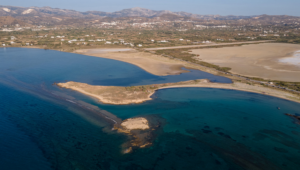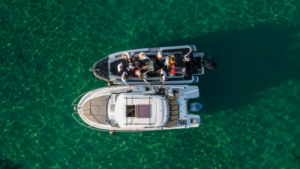If anyone had passed by the previous days from the Laguna area of the airport in Naxos (Laguna Coast), they would have encountered a different picture from those seen in the rest of the crowded and touristic spots of the island. There, a colorful group of students from the USA, Spain, France, Sweden, Romania, who worked passionately all day in an environment of enormous environmental value, met there early in the morning.
The research team of the University of Athens under the responsibility of the professor in the Department of Geology and Geoenvironment, Mr. Nikis Evelpidou, has been doing great work for years and what they have managed to discover in this magical spot of Naxos will surprise you.
What makes Laguna special? Where is the ancient beach hidden? What method of green practice was discovered on the island that has sparked the interest even of Japan? Why do the beaches of Western Naxos, such as Agios Prokopios have these clear waters? Answers to all these and even more were given to us by Mrs. Evelpidou as well as by the Laguna Coast Foundation, the organization that aims to support the plan to upgrade and protect this rare area.


Why the airport lagoon is so important
It is no coincidence that this coastal wetland of the Cyclades, just 3 kilometers from the town of Naxos, has become a case study for foreign universities. It is a heaven on earth that offers excellent climatic conditions, rare geological phenomena, a unique underwater world and a rich variety of flora and fauna. It was the natural port of the island in ancient times and is a living testimony of the history of humanity as it is a game of destruction and creation, between the land and the sea.
Here is the Naxos salt flat and we actually have a complex of different habitats on an area of 1,000 acres, with more than 80 species of plants, which is also a stopover for migratory birds. In the past, this salt flat was a coastal wetland that communicated directly with the sea, but over the years a dam was created that trapped the waters, so today only a moat connects the fresh waters to the Aegean Sea.
At the same time, the evolution and history of the region holds the key to fundamental questions about the future of biodiversity, the climate crisis and the holistic approach to life.
What did universities do in their mission?
The research mission, consisting of more than 50 scientists, was organized by the Department of Geology and Geoenvironment of the National and Kapodistrian University of Athens in collaboration with leading universities worldwide. The aim was to make measurements, collect data and understand the special importance of the area.
The participating universities were those of Budapest, Madrid, Stockholm, Aix-Marseille (France) and Charleston (USA), while Professor Niki Evelpidou was in charge of the educational program.
The students are divided into groups, take out sediment, take measurements and from the data then see what will happen to the environment in the coming years. Will the sea move? In which direction; How much;

(Students take measurements)

(Students from all over the world met in Naxos)

The ancient beach
Laguna Coast is a special environment of great value as it has a lagoon behind it, while in front it is covered by 4 rows of reefs. The reefs are large slabs (hence the name Plaka of the island’s famous beach) and the remarkable thing is that they actually constitute an ancient beach, which nature cemented with whatever material was available: pebbles, sand, shells… It is an ancient monument of nature, which in fact gave birth in that area to an idea that can help the entire planet.
“Laguna Coast of Naxos is a place with ideal conditions, a place where life once thrived and can do so again” as the CEO of the Laguna Coast Foundation, Antonis Pittaras, said.

(The CEO of the Laguna Coast Foundation, Antonis Pittaras)

(The lagoon can be seen behind the beach)


The idea that was born in Naxos and travels all over the world
As is well known for many years we have been experiencing global warming with the ice caps melting and more sweet water is entering the ocean basin. The results are visible in many parts of the Earth, while scientists are sounding the alarm about areas that will be flooded with water. Mrs. Evelpidou one day, years ago, when it was very windy in Naxos, climbed the sand dunes of the Lagoon and began to wonder: “It is a vulnerable and sensitive environment, the sand is so thin, so the wave should take it. Why doesn’t it leave?’ The answer is that it doesn’t disappear because of the reefs as the wave action dissipates and it’s really a huge gift to Naxos that on the west side there are so many sea cliffs protecting the magnificent beaches.

(The “soul” of the program is EKPA professor Niki Evelpidou)
From there, an idea was born to protect the areas that do not have coastal rocks. Why not imitate the nature that integrated its material? Why not make seawalls with sand and features from the beach that we need to protect? The experiments were done, they were highly successful and a new method of green practice was created. Thus Naxos set a mark on the world community on what we must do to avoid erosion. Department of Geology and Geoenvironment Dr. Yannis Saitis, pointed out that this method is now traveling as far as Japan and has attracted worldwide interest.
Key California Assembly committee blocks bill to make child trafficking a ‘serious felony’

(The sunset behind the reefs)


The very important sand dunes and why we shouldn’t…hate seaweed and stones in the sea
Sand dunes play a very important role in the development and protection of the environment and this becomes very visible in Laguna. It is the first “wall” against the big waves, which, as everything shows, we will see more and more often now. If behind a beach there is just a wall, for example, the water returns with the same force and sweeps away everything in its path. But if there are sand dunes, the wave passes through and does not return with the same energy. And sometimes tourists resent sand dunes, sea stones or seaweed, but if they knew their importance they would think differently. For example: Have you been in a forest and get angry that the leaves are down? Likewise, algae are the leaves of the vegetation in the water and in fact are an indicator of cleanliness for the place we swim.

Why do the beaches of Naxos have such clear waters?
In Laguna you also see caves about which you learn very important things, such as for example the granodiorite that exists there, an igneous rock with a lot of quartz material that produces the best quality sand available. That is why the island is full of unique beaches with clear waters and amazing sand that does not burn or stick on you.
What can we do?
Informing the public is always key to raising awareness of environmental issues. In Laguna, the residents and visitors of Naxos had the opportunity to meet the scientists and learn about what is happening at the site. As the dean of the School of Positive Sciences of the National and Kapodistrian University of Athens, Ioannis Emmanouil, said, “cutting-edge research is carried out at EKPA and it is important that this research be spread to society”.
The actions that need to be taken are many and are also related to changing our attitude and the image we have of the Greek summer and bathing in the sea, but also of the tourist product we offer. As the experts point out, we must protect our beaches in every way. Stones and algae in the water act as a “veil of protection” and that is why it is a big mistake when municipalities or private individuals proceed to remove them to create a more idyllic landscape. Also, parking almost on the beach, something we see very often on the islands in the summer, is “traumatic” for the environment. Specifically for Laguna, the Laguna Coast Foundation has drawn up a master plan to restore the lake and mitigate the environmental footprint in the coastal area.








Ask me anything
Explore related questions





